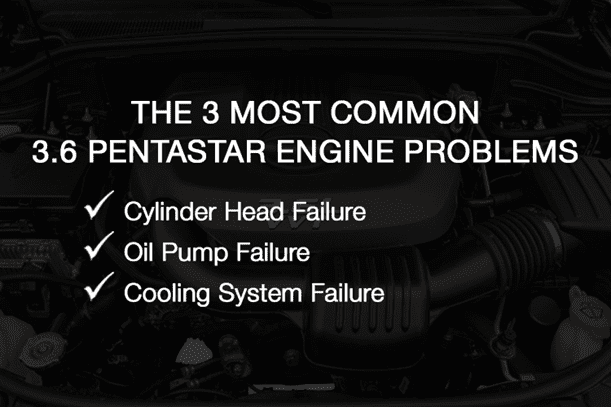Introduction
The 3.6 Pentastar engine was introduced for the Chrysler, Jeep, and Dodge vehicles about a decade ago. This machine is quite durable, as the 3.6 Pentastar engine’s life expectancy is over 200,000 miles without much difficulty.
Nonetheless, there are some common technical faults that you might experience while using a 3.6 Pentastar. Therefore, it is best to be prepared so that these challenges will not come as a shock to you.
Read on to know the three typical Pentastar 3.6 engine issues, as well as their causes and solutions.
1. Cylinder Head Failure
Cylinder head failure was common in the initial release of the 3.6 Pentastar engine in 2011 and 2013. The second cylinder of the V6 engine was constantly overheating. Consequently, this factor causes the failure of the left bank cylinders. Luckily, Chrysler was able to get past the problem in a relatively straightforward fashion.
They changed the valve guides and seats to hardened ones, and it worked out well. Those who purchased the engine already were not so happy. Fiat Chrysler Automobiles (FCA) pacified them and granted them an extended warranty on their engines.
Symptoms of cylinder head failure
The primary ways to diagnose cylinder head failure are:
- Notable loss of engine power
- Engine ticking
- Engine misfire
- Engine light notification
If you can’t identify all of the symptoms, you should at least know how to check your engine light. If you see indications from the light, don’t ignore them. Driving your vehicle with engine problems like this would only worsen the situation.
Cause
This problem arises from the manufacturing process of the Pentastar 3.6 engine. It occurs due to overheated valve seats in the second cylinder of the engine. On most occasions, cylinder head failure affects the left bank of the 3.6 Pentastar.
Solution
The only solution is to get the complete replacement of the cylinder head. If you recently got any vehicle with the Pentastar, you don’t need to worry. FCA rectified the issue during the production of further editions of the engine.
2. Oil Pump Failure
The Pentastar engine could also possibly see a massive drop in the oil levels due to pump failure. Although this issue is not really common on the engine, it is worth the mention. Thankfully, the engine has a defense mechanism called the Electric Control Unit (ECU). This system will diagnose any oil flow problem and rectify it as early as possible.
Oil pump failure could be a headway for other problems in your engine. For this reason, you must address it quickly.
Symptom
There are a few things you could look out for to detect oil pump failure:
- Unusual noise from the engine
- A higher engine temperature
You don’t have a direct indicator to notify you when such an issue occurs. However, you can make good use of your temperature gauge. If you notice unusually high-temperature readings, you should be suspicious of an oil pump problem.
Cause
Oil pump failure doesn’t have specific or notable causative factors. However, here are a few reasons why it can happen:
- Low engine oil level
- Oil passage problem
- Faulty bearing balance
Nevertheless, the chances that you experience an oil pump failure are low, provided that you maintain your engine appropriately. However, if your 3.6 Pentastar engine is old, there is a high probability of facing this issue.
Solution
You won’t find damages more often because the Electric Control Unit automatically solves the problem. Most times, the ECU resolves the issue before you find out. However, if it gets worse, the only possible solution may be to replace the oil pump.
3. Cooling System Failure
The cooling system encapsulates both the radiator and water pump of the Pentastar. They work hand in hand. And if there is a problem with any of them, the cooling system fails. It could also extend to other parts of the engine, like the oil cooler and heater core.
Symptom
Here are things that give you a sign that your Pentastar has cooling system failure:
- Overheating
- Coolant leak
- Engine light indication
- A/C fault
You could quickly identify any of these symptoms in your vehicle. Overheating is the perfect signal in this case. If you notice an unusual overheating indication, it has to be a problem with the cooling system. Keep an eye on the engine light too, it comes in handy to diagnose a cooling network failure.
Cause
This problem takes its root in the manufacturing problem of the 3.6 Pentastar. The primary manufacturing process for this engine is sand-casting. In the course of production, some grains of sand are left behind in the hooks and crannies of the engine.
Although the manufacturers do their best to clean up the grains and tidy up the engine, there are usually residual deposits, even after the final production.
It is not usually a problem until the sand particles start to make their way into the cooling system; this could be the radiator or water pump. Over time, the sand particles formulate into sludge and sediments all through the system.
The deposits can affect the water pump, heater core, oil cooler, and radiator of the 3.6 Pentastar.
Solution
Fixing cooling system issues may be a bit out of your reach. Your only responsibility is to detect the fault. You need to take your Pentastar engine to a repair shop as such fault requires the replacement of damaged components.
Sum Up
Pentastar remains a durable and reliable engine to this day. Most of these problems were resolved back in 2013 when the manufacturers noticed them. Don’t let it discourage you from getting a vehicle model that runs on this engine.
Ignoring warning signs may worsen things for your 3.6 Pentastar engine. If you feel that you can oversee the solution, then carry on fast; if not, get it to an automotive expert.







